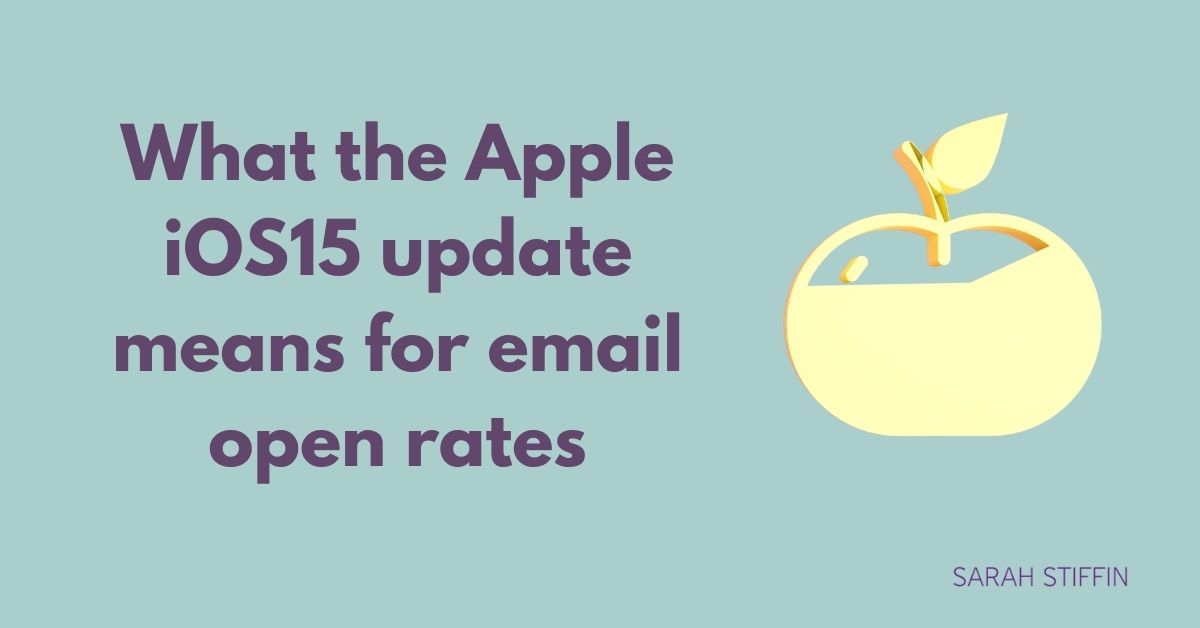In the Apple iOS 15 update due from September 2021, Apple have announced more privacy-focused updates including two that affect email marketing.
Apple are big on privacy right now, which on the whole is great for us and ensuring people continue to have confidence over how their data is used.
But sometimes these privacy features do have repercussions for small businesses. Apple has already taken steps in earlier updates to stop mobile apps tracking our activity, which has had consequences for Facebook ads targeting.
So what exactly are Apple introducing
The two iOS 15 features that will impact email marketing are the “Mail Privacy Protection” and “Hide My Email”.
Under Mail Privacy Protection, which users have to opt-in to use, Apple has the ability to block IP addresses and location, and, perhaps more importantly, prevents senders from knowing if an email has been opened.
When you send an email from your email service provider (ESP) such as Mailerlite or Active Campaign, your message will include a tracking pixel.
This tiny 1px x 1px image is embedded into your email, usually in the header or footer. It cannot be seen by your recipients. When your email is opened, the pixel fires and reports the open back to your ESP . What Apple will now do is pre-load all images in an email before it’s actually opened by the subscriber, thus skewing open rates.
I should add that this is only applicable to users who open their email using Apple Mail. Since a large percentage of people use Apple for email according to this email client share report from Litmus, this looks like it could cause a problem for email marketers.
The other feature Apple are introducing is Hide My Mail. Users are able to opt-in to receive emails from a business using a randomly generated Apple email address rather than their own personal email address.
When a business sends out a marketing email, Apple will forward anything sent to that random address onto a user’s regular address. It will be very easy people to use a random Apple-generated email each time they opt in and to bin the previous one. This could well affect deliverability and at worst the domain reputation of the sender.
Why we need to be able to track open rates
We use open rates as one of the main analytics to measure our email marketing. Several companies regularly issue ‘open rates by industry’ reports and businesses aim for the magical all-industry-average 20%.
Now, open rates aren’t a precise art. There are several reasons why they aren’t always accurate (I won’t bore you with the techy stuff now) but on the whole they are a fairly decent-ish indicator of how many emails are being opened.
We can use this data to help us clean our lists since regularly sending to people who never open your emails can affect deliverability. If we don’t know who is opening our emails, we can’t unsubscribe and delete them.
But if we can’t track open rates properly then keeping our lists clean is going to be harder.
Open actions are often used in automations too to decide whether someone moves on to the next step of the workflow. For example, if your message which sends a free resource isn’t opened, or the reminder email is also unopened, then a condition that looks for opens might stop them moving on to the rest of your nurture sequence. So relying on ‘opens’ might affect your workflows.
Should we measure click-through rates instead?
We could yes. I always look at click through rates because they indicate people are responding to your call to action. Perhaps you’re asking people to click through to read the rest of your blog, listen to your podcast or buy a product.
But not all emails have a link to click. Some senders like to keep their best content for their subscribers and just put blooming good valuable content in their emails.
It looks like we’ll have to rethink calls to action and ‘train’ our subscribers to click through.
The update also blocks IP address and location
This is another tick for privacy and for the most part is welcomed. But what about those email marketers who rely on location-based segmentation.
A business that holds workshops around the country might rely on location tracking to send emails about a particular workshop. If this applies to your business then make sure you ask your subscribers for their location at the point of opt-in and save it as a custom field.
So what should you do now?
- Firstly, don’t panic!
- Carry on sending great value content to your subscribers.
- Get familiar with other analytics other than ‘opens’.
- Start to train subscribers to click through to content elsewhere
- Wait to see what happens to your open rates once the update goes live.
And stay tuned to my blogs and email updates for more on this subject and best practices for email marketing.
Need some help with your email marketing? Apply to work with me here..


0 Comments